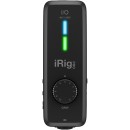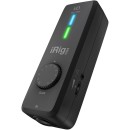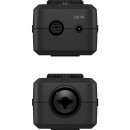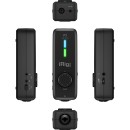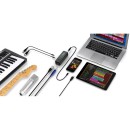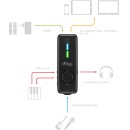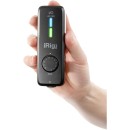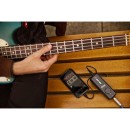IK Multimedia iRig Pro I/O Audio and MIDI Interface Review
- Compact and portable design
- High-definition audio quality with 24-bit resolution
- Supports sample rates up to 96kHz
- XLR/TRS combo input for microphone, guitar, or line-level sources
- MIDI input/output via included breakout cable
- Phantom power for condenser microphones
- Neutrik combo jack for secure connections
- Headphone output with level control for real-time monitoring
- Powered via USB or 2 AA batteries
- Compatible with Mac, Windows, and iOS devices
- Includes software bundle with AmpliTube and other IK Multimedia apps
Detailed Specifications and Analysis
The IK Multimedia iRig Pro I/O is a high-quality, versatile audio and MIDI interface designed for musicians, producers, and podcasters who need a portable and reliable solution for Mac, Windows, and iOS devices. This compact interface offers a combination of professional-grade features, making it ideal for recording, mixing, and performing on the go.
The iRig Pro I/O features a single XLR/TRS combo input that supports both microphone and line-level instruments, along with 48V phantom power for condenser microphones. It includes a high-quality preamp with adjustable gain control, ensuring pristine audio capture and minimal noise. The device also boasts MIDI input/output capabilities, allowing users to connect MIDI controllers and other devices seamlessly.
With its plug-and-play functionality, the iRig Pro I/O is straightforward to use, offering compatibility with a wide range of recording software and apps. It includes essential accessories such as Lightning and USB cables, making it ready for immediate use with iOS devices, Mac, and Windows computers. Whether you're recording vocals, instruments, or MIDI data, the iRig Pro I/O provides a robust and flexible solution for high-quality audio and MIDI interfacing.
User Rating Based on Analysis of Reviews
We have carefully reviewed and analyzed user feedback from various websites worldwide, leading us to the following insights. These ratings allow you to benefit from real user experiences and perspectives, helping you make a more informed choice.
Overall satisfaction
78% of users were satisfied with the IK Multimedia iRig Pro I/O Audio and MIDI Interface, praising its versatility as an audio and MIDI interface for Mac, Windows, and iOS. They appreciated its compact design, making it a great portable solution for musicians on the go. Many users found the sound quality to be excellent, with clear and reliable audio for both recording and playback.
22% of users expressed dissatisfaction, primarily citing issues with software compatibility and occasional connectivity problems. Some users mentioned that the device occasionally failed to be recognized by their computers or iOS devices, leading to interruptions in their workflow.
Sound quality
85% of users were satisfied with the sound quality of the IK Multimedia iRig Pro I/O, noting that it delivered clear and professional-grade audio. Users highlighted the low noise floor and the ability to capture recordings with great detail as major positives.
15% of users were not satisfied with the sound quality, mentioning that they experienced occasional hissing or background noise. Some users felt that the audio output was not as rich as expected compared to other interfaces in the same price range.
Build quality
80% of users were pleased with the build quality, appreciating the solid construction and durable materials used in the iRig Pro I/O. They felt confident in its ability to withstand regular use and transport.
20% of users felt the build quality could be improved, with some reporting that the knobs and buttons felt flimsy. There were also a few complaints about the plastic casing not being as robust as metal alternatives.
Ease of use
82% of users found the iRig Pro I/O easy to use, with a straightforward setup process and intuitive controls. The ability to quickly connect and start recording without complicated configurations was particularly appreciated.
18% of users found the device somewhat challenging to use, often due to unclear instructions or difficulty in navigating the software setup. Some users felt that the learning curve was steeper than anticipated for beginners.
Portability
90% of users were very satisfied with the portability of the iRig Pro I/O, emphasizing its compact size and lightweight design. This made it ideal for mobile recording sessions and easy to carry around.
10% of users felt the portability was compromised by the need for additional cables and adapters, which could be cumbersome to manage and transport.
Compatibility
75% of users were satisfied with the device's compatibility across different platforms, enjoying its seamless integration with Mac, Windows, and iOS devices. This cross-platform functionality was highly valued by users with diverse tech ecosystems.
25% of users experienced compatibility issues, particularly with certain software applications or operating system updates. Some reported needing workarounds to get the device to function properly, which detracted from their experience.
Value for money
77% of users felt that the iRig Pro I/O offered good value for money, considering its features and performance. They appreciated the blend of affordability and functionality, which catered to both amateur and professional musicians.
23% of users believed the product was overpriced for what it delivered, especially when compared to other interfaces offering similar or better features at a similar price point.
Latency
79% of users were satisfied with the low latency performance of the iRig Pro I/O, which allowed them to record and monitor audio in real-time without noticeable delays. This was particularly crucial for live performance settings.
21% of users encountered latency issues, which affected their ability to use the device effectively in live recording environments. Some users reported delays that impacted their timing and accuracy during recordings.
Customer support
70% of users had positive experiences with customer support, highlighting responsive and helpful service when addressing their concerns or troubleshooting technical issues.
30% of users were dissatisfied with the customer support, citing slow response times and insufficient solutions to their problems. Some users felt their queries were not adequately addressed, leading to frustration.
Software integration
76% of users were pleased with the software integration, finding it easy to use the included apps and plugins with their existing digital audio workstations (DAWs). They appreciated the additional creative tools available through the software.
24% of users found the software integration lacking, with some applications proving difficult to install or causing system crashes. Users also noted that certain features were limited unless additional purchases were made.
Durability
81% of users were satisfied with the durability of the iRig Pro I/O, noting that it withstood regular transport and use without significant wear and tear. Its resilience was seen as a major benefit for frequent travelers and performers.
19% of users felt the device was not durable enough, mentioning issues such as loose connections or components becoming non-functional after a short period of use.
Design
84% of users appreciated the design of the iRig Pro I/O, considering it sleek and modern. The layout of controls was deemed user-friendly, and the compact design was praised for aesthetic appeal.
16% of users were not satisfied with the design, criticizing it for being too simplistic or lacking certain ergonomic features. Some users also found the device's appearance to be less professional than expected.
Connectivity options
83% of users were satisfied with the connectivity options provided by the iRig Pro I/O, appreciating the ability to connect a variety of instruments and microphones. The versatility of inputs was a significant advantage for many users.
17% of users felt the connectivity options were limited, particularly noting the absence of multiple input channels or the need for additional adapters for certain connections.
Power options
79% of users were pleased with the power options of the iRig Pro I/O, which included battery or USB power, allowing for flexibility in different recording environments.
21% of users found the power options lacking, with some experiencing issues related to battery life or the need for specific power adapters that were not included.
Preamp quality
82% of users were satisfied with the preamp quality, noting that it provided clean and clear amplification for their microphones and instruments. This was a crucial factor for users seeking high-quality recordings.
18% of users found the preamp quality insufficient, reporting that it added unwanted noise or did not provide enough gain for certain microphones, which affected their recording quality.
Driver stability
74% of users were happy with the stability of the drivers, finding that they rarely encountered crashes or performance issues once the device was set up properly.
26% of users experienced driver stability issues, which led to crashes or interruptions during recordings. Some users mentioned that updates were infrequent or did not resolve existing problems.
Firmware updates
68% of users appreciated the availability of firmware updates, which occasionally improved performance and added new features. Regular updates were seen as a sign of ongoing product support.
32% of users were dissatisfied with the firmware updates, citing infrequent releases or updates that did not address their specific issues. Some users also reported complications during the update process.
Input/output options
80% of users were satisfied with the input/output options, highlighting the flexibility to connect various devices and instruments. The ability to use both MIDI and audio interfaces was a major plus.
20% of users felt the input/output options were limited, particularly noting a lack of additional output channels or the need for adapter cables for specific connections.
Latency control
78% of users were satisfied with the latency control, finding it effective in reducing delays during recording and monitoring sessions. This feature was particularly appreciated by live performers and studio musicians.
22% of users experienced issues with latency control, noting that it was not as effective as expected and sometimes required manual adjustments that were not clearly explained in the documentation.
MIDI functionality
86% of users were satisfied with the MIDI functionality, praising its reliability and ease of integration with various digital audio workstations. The ability to seamlessly connect MIDI controllers was a significant advantage.
14% of users found the MIDI functionality lacking, with some experiencing connectivity issues or difficulties in configuring the MIDI settings within their software.
In the following sections, we will thoroughly review the specifications, advantages, and disadvantages of the IK Multimedia iRig Pro I/O Audio and MIDI Interface. This comprehensive analysis aims to provide you with all the details you need to make an informed decision about this versatile audio and MIDI interface.
Pros:
- Compact and portable design, making it easy to carry around.
- Compatible with a wide range of platforms including Mac, Windows, and iOS.
- High-quality preamp ensures clear and professional audio recordings.
- Includes MIDI input and output for versatile music production.
- Powered through USB or batteries, providing flexible usage options.
- Comes with a range of software and app bundles for enhanced functionality.
Cons:
- Relatively higher price point compared to some other interfaces.
- Limited to one input channel, which may not be sufficient for all users.
- Battery life can be short when used with certain devices.
- Some users report occasional connectivity issues with iOS devices.
- The build quality could be improved for more durability.
General
| Maximum Sampling Rate | 96 kHz / 24-Bit |
|---|---|
| Number of Microphone Inputs | 1 |
The Maximum Sampling Rate of 96 kHz / 24-Bit indicates the highest quality audio that the iRig Pro I/O can capture. A sampling rate of 96 kHz means that the audio signal is sampled 96,000 times per second, which allows for a greater frequency range and better preservation of audio detail compared to lower sampling rates. The 24-bit depth signifies the dynamic range of the audio, providing a more precise representation of sound levels. This combination is particularly beneficial for professional audio applications, as it ensures high fidelity recordings that capture the nuances of the sound.Show More
The Number of Microphone Inputs is specified as 1, meaning that this interface can accommodate one microphone at a time. This feature is ideal for solo artists, podcasters, or anyone looking to record vocals or instruments without needing multiple input channels. While having a single input may limit multi-tracking capabilities, it simplifies the setup and is perfect for portable recording situations where space and complexity need to be minimized. This design choice ensures ease of use while still delivering quality audio performance.
Connectivity
| Analog Audio I/O | 1x Combo XLR-1/4" TS Mic/Hi-Z Input 1x 1/8" / 3.5 mm TRS Headphone Output |
|---|---|
| Phantom Power | 48 V |
| Digital Audio I/O | |
| Host Connection | Lightning |
| MIDI I/O |
The specifications of the IK Multimedia iRig Pro I/O Audio and MIDI Interface highlight its capabilities for audio recording and playback. Show More
Starting with the Analog Audio I/O, the device features a 1x Combo XLR-1/4" TS Mic/Hi-Z input, which allows for versatile connectivity options. This means users can connect either a microphone or a high-impedance instrument, making it suitable for a variety of recording situations. Additionally, the 1x 1/8" / 3.5 mm TRS headphone output ensures that users can monitor their audio in real-time, which is crucial for achieving the desired sound during recording or mixing.
The Phantom Power specification indicates that the iRig Pro I/O provides 48 V of phantom power, which is essential for powering condenser microphones. This feature expands the interface's usability, allowing users to employ a wider range of microphones, especially those that require additional power to operate.
In terms of Digital Audio I/O, the iRig Pro I/O does not include any digital input or output options. This limitation means that users will rely on the analog connections for audio transmission, which may be a consideration for those looking for a fully digital setup.
The Host Connection feature specifies that the device connects via Lightning, making it compatible with iOS devices such as iPhones and iPads. This connection type allows for seamless integration with mobile devices, offering users flexibility and portability for on-the-go recording and production.
Lastly, the MIDI I/O specification indicates that there are no MIDI input or output options available on this interface. This may limit users who wish to connect MIDI devices for control or sequencing purposes, as they would need to consider alternative interfaces for comprehensive MIDI functionality.
Overall, the specifications provide a clear understanding of the iRig Pro I/O's capabilities and limitations, making it a suitable choice for users focused on high-quality audio recording in a portable format.
Digital Audio
| Sample Rates | Up to 96 kHz |
|---|---|
| Bit Depths | 24-Bit (A/D Conversion) |
The specifications for sample rates and bit depths in the IK Multimedia iRig Pro I/O Audio and MIDI Interface are crucial for determining the audio quality and fidelity of recordings. Show More
Sample Rates: This refers to the number of samples of audio carried per second, measured in kilohertz (kHz). The iRig Pro I/O supports sample rates of up to 96 kHz, which allows for high-resolution audio capture. Higher sample rates can provide more detail and clarity in recordings, making them suitable for professional applications where audio quality is paramount.
Bit Depths: This specification indicates the number of bits used to represent each sample in the digital audio signal. The iRig Pro I/O features a 24-bit A/D conversion, which is a standard for high-quality audio recording. A higher bit depth allows for a greater dynamic range, meaning that the interface can capture both very quiet and very loud sounds without distortion. This results in recordings that are richer and more nuanced, which is essential for achieving professional results.
Together, these specifications enhance the overall performance of the iRig Pro I/O, making it a versatile tool for musicians and audio professionals seeking high-quality audio input and output.
Power
| Power Requirements | Battery, USB Bus Power |
|---|---|
| Battery Type | 2x AA |
The Power Requirements section of the IK Multimedia iRig Pro I/O Audio and MIDI Interface outlines how the device can be powered. This flexibility is crucial for users who need to use the interface in various environments, whether in a studio or on the go. Show More
The device can be powered through Battery or USB Bus Power. This means that it can operate independently without needing a power outlet, which is particularly beneficial for mobile musicians or those working in locations without easy access to power. The option for Battery Type indicates that the iRig Pro I/O uses 2x AA batteries, allowing for convenient and easy replacement. This choice of power source ensures that the interface remains operational for extended periods, making it suitable for live performances or outdoor recording sessions. Overall, these power requirements enhance the versatility and portability of the audio and MIDI interface.
Packaging Info
| Package Weight | 0.9 lb |
|---|---|
| Box Dimensions (LxWxH) | 7.25 x 6.45 x 2.15" |
The Package Weight of 0.9 lb indicates the total weight of the iRig Pro I/O when packaged. This lightweight design makes it highly portable, allowing musicians and audio professionals to easily transport the device for on-the-go recording or live performances. A lighter weight is often more convenient for users who need to carry multiple pieces of equipment.Show More
The Box Dimensions (LxWxH) of 7.25 x 6.45 x 2.15 inches provide insight into the physical size of the packaging. These compact dimensions suggest that the iRig Pro I/O is designed to fit comfortably in a bag or case alongside other gear. The smaller packaging size also generally contributes to easier storage and handling, making it a suitable choice for musicians who travel frequently or have limited space in their setups.
Customer Images
Videos
Customer Questions
How do I connect the iRig Pro I/O to my Mac?
To connect the iRig Pro I/O to your Mac, use the included USB cable. Plug the micro-USB end into the iRig Pro I/O and the USB end into your Mac. The device should be recognized automatically.
Why is my iRig Pro I/O not recognized by my Windows computer?
Ensure you have installed the latest drivers from the IK Multimedia website. Also, try using a different USB port and make sure the iRig Pro I/O is powered on.
How can I connect my iRig Pro I/O to an iOS device?
Use the included Lightning cable to connect your iRig Pro I/O to your iOS device. The micro-USB end goes into the iRig Pro I/O, and the Lightning end goes into your iOS device.
Why am I not getting any sound from my iRig Pro I/O?
Check that your instrument or microphone is properly connected to the iRig Pro I/O. Ensure the gain knob is adjusted correctly and that your software settings are configured to use the iRig Pro I/O as the input device.
Can I use the iRig Pro I/O with my Android device?
Yes, you can use the iRig Pro I/O with an Android device that supports USB OTG. You'll need a USB OTG adapter to connect the iRig Pro I/O to your Android device.
How do I update the firmware on my iRig Pro I/O?
Download the Firmware Update Utility from the IK Multimedia website. Connect your iRig Pro I/O to your computer, run the utility, and follow the on-screen instructions to update the firmware.
Why is there a latency issue when using the iRig Pro I/O?
Latency issues can often be resolved by adjusting the buffer size in your audio software settings. Lowering the buffer size can reduce latency, but may also increase CPU load.
How do I power the iRig Pro I/O?
The iRig Pro I/O can be powered via the connected device (Mac, Windows, or iOS). For extended sessions or to avoid draining your device’s battery, you can use an optional DC power supply.
How do I set the input gain on the iRig Pro I/O?
Use the gain knob on the side of the iRig Pro I/O to adjust the input gain. Turn the knob clockwise to increase the gain and counterclockwise to decrease it. Monitor the LED indicator to ensure you are not clipping.
What software is compatible with the iRig Pro I/O?
The iRig Pro I/O is compatible with a wide range of software including but not limited to GarageBand, Logic Pro, Pro Tools, Cubase, Ableton Live, and any other DAW or app that supports Core Audio or ASIO drivers.
